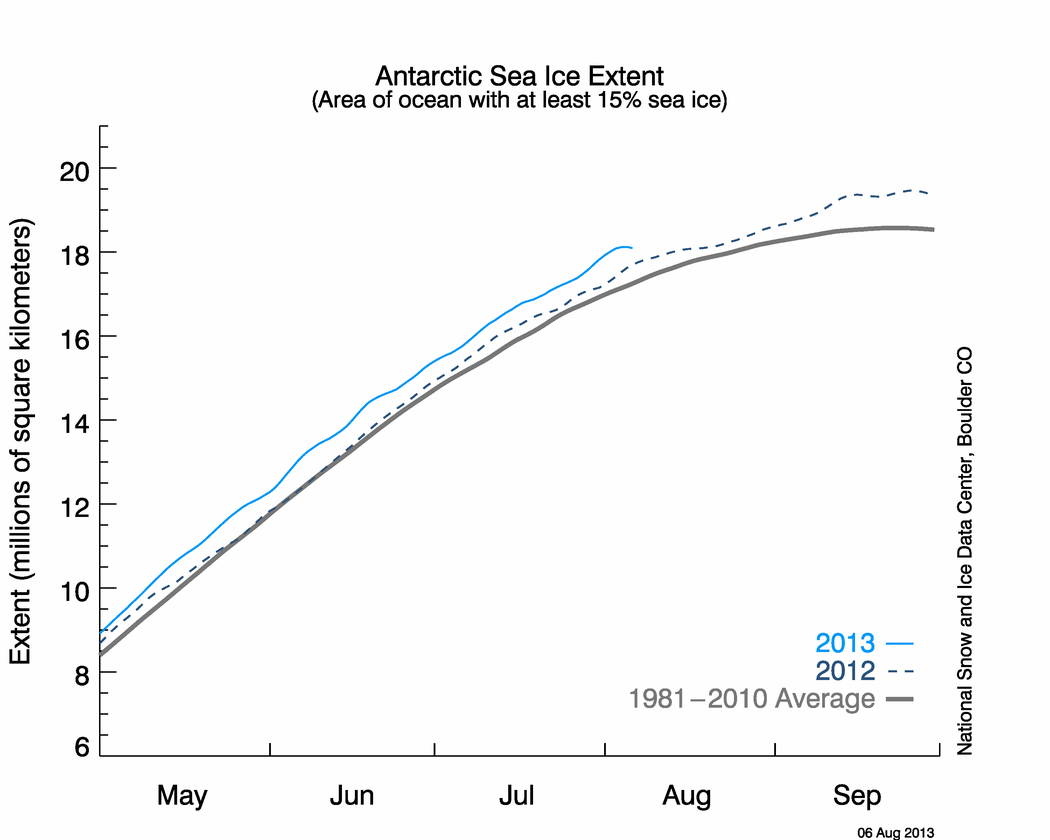
It does appear that the Arctic ice has in recent years been undergoing one of its periodic shrinkages. That such shrinkages are periodic and normal the image above shows rather vividly. It is a photograph showing U.S. nuclear submarine "Skate" surfaced at the North Pole on 17 March, 1959 -- a time when the ice-pack is at its seasonal thickest for the year. There was clearly very little ice-cap at all that year
When we note that the current shrinkage of Northern sea-ice has been accompanied by an EXPANSION of sea-ice at the SOUTH pole it becomes obvious that there is no global phenomenon involved -- merely local changes. That the article below claims a global effect is therefore a straight-out lie. The scientists concerned can hardly be unaware of the Antarctic ice expansion so the lie is a deliberate one

National Snow and Ice Data Center graph
Another reason why it is a deliberate lie is that even Rajendra Pachauri and Jim Hansen now concede that there has been NO global warming for over 15 years. And something that does not exist cannot cause ANYTHING, let alone "changes to the food chain". Even a Humean account of causation makes that clear
Major changes to the food chain, weather and landscape of Antarctica have provided stark evidence of the impact of global warming, a report on a polar expedition has revealed.
The preliminary report on the research by scientists from the Australian Antarctic Division and the Woods Hole Oceanographic Institute near Boston suggest significant changes at the lowest level of the food chain, a vital source of sustenance for seabirds, seals and whales.
The Climate Commission recently said there was evidence natural events were being influenced by climate change as greenhouse gases accumulated and trapped measurable amounts of extra energy in the atmosphere and oceans.
The expedition senior scientist of the Australian Antarctic Division, Steve Nicol, said in 25 years of surveying Antarctica, this was the first time he had experienced rain.
The findings from the report are the focus of a new exhibition at the Australian National Maritime Museum.
Data from the expedition in 2010 is still being collated but a selection from the 20,000 images to be used for monitoring future change will go on show from Saturday in Elysium Antarctic Visual Epic.
"Warming is evident in the moistness of the air in this area of the world's driest continent. Rain is now not uncommon and whilst this may encourage plant life, it is probably detrimental to the health of many of the breeding birds," it found.
"This moistness also results in more snow falling and this too can affect the breeding habits of nesting birds when it falls during their incubation period, burying their eggs in the cold snow.
"The glaciers draining the ice caps of the islands and the mountains of the peninsula are shrinking, too. This has resulted in the formation of more icebergs and a greater run-off of freshwater."
Expedition leader Michael Aw said the team witnessed an increase in herbivores called salps, possibly at the expense of phytoplankton, which are consumed by fish and krill.
"The balance in the herbivore elements of the food chain determine the types of larger animals that can be supported," he said. "There are suggestions it is changing from one that supports krill and its predators [seabirds, seals, whales] to one that may result in more fish and possibly squid … The whales also feed on the krill so there is a chain reaction."
SOURCE
Posted by John J. Ray (M.A.; Ph.D.).
No comments:
Post a Comment